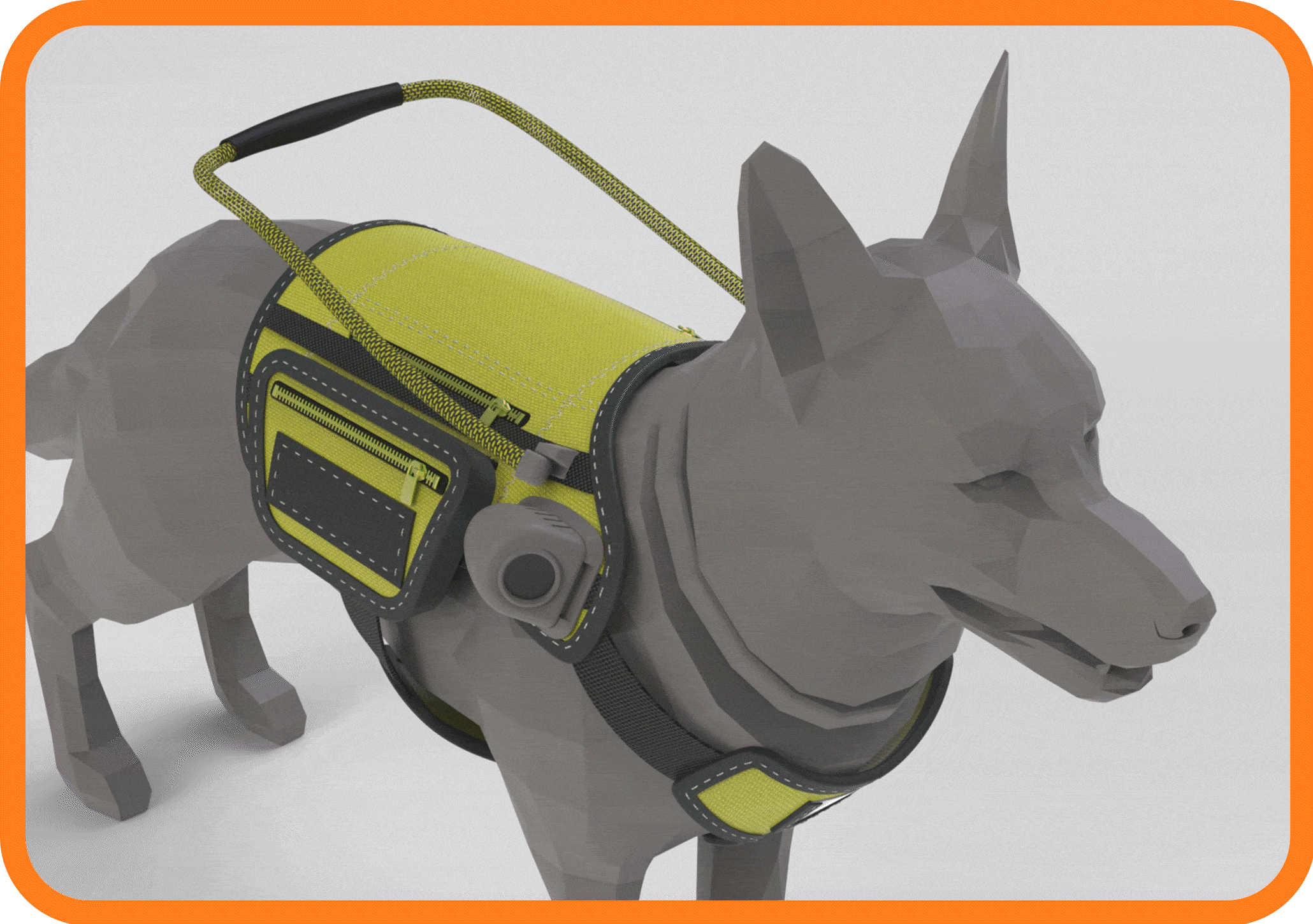.png)

Search & Rescue Harness
Adapt, Protect, Rescue, Repeat.

Design Problem & Goals
Design Problem:
Existing search and rescue dog harnesses often lack comfort, protective features, and functionality, leading to discomfort, restricted movement, and inefficiency during missions. They lack ergonomic design, insulation against harsh weather, and the capacity to carry mission resources effectively. They also overlook strengthening the handler-dog bond. A new harness design aims to address these issues, emphasizing safety, comfort, functionality, and the handler-dog relationship while symbolizing aid in disaster situations.
One trained dog equals 60 Search-and-Rescue workers.
~Charles Stoehr
It takes about 600 hours for a dog to be field ready to search and rescue dog. It is estimated to cost $30,000 to train a search and rescue dog.
(HowStuffWorks, 2005)
The goals of this harness are as follows:
-
Enhance the efficiency of search and rescue missions employing working dog breeds to save more lives.
-
Prioritize the safety and comfort of working dog breeds during extended periods of work.
-
Strengthen the connection and bond between the handler and the dog during their operations.
-
Serve as a symbol of aid in disaster situations.

Ideation Development
Original Concept: Rescue Harness:
All-Terrain dog boots
High Viz Spinal/ Back support
First-Aid Pack
High Viz staps /
Name Tag
Red Nylon Body cover
Dog Food /
Water pack
The original rescue harness was designed with a primary focus on enhancing the safety and comfort of search and rescue dogs while also optimizing the efficiency of their operations. It prioritized safeguarding the critical areas of the S&R dog and providing ample capacity for carrying essential mission resources.

Service Dog Harness Analysis:
Garb/ Hold Handel
Velcro Service Dog Tags
Adjustable Buckel Straps
Adjustable High-Viz Collar
Overhead Attachments
3-Point Leash Attachment
Functioning Physical Prototype
Final Concept:
Final Concept:
Final Concept:
Final Concept:
Fully Adjustable
Handle/ Lead
Expandable bags & Modular Packs
3/4 Size 3 Part
Harness
Template

Position the harness components onto the dog's key areas (the abdomen, back, and chest).
Connect and adjust each component using quick-release safety clips. Attach ID and relevant information tags
Use the adjustment slide to set the dog lead to the desired distance and angle, matching the handler’s preference.
Fix shoulder attachments (torches and camera) to the quick-connect mounts for enhanced visibility.
Attach modular electronic component packs to harness and connect electronics. (Battery, GPS Tracking)
Unzip to extend the collapsible backpack stored within the harness. (Additional storage for first-aid and supplies).

Final Design & Features
Modular Attchments
User Customisable
Colour Ways
Boot Tread:
Final Boot Model:
Carrying Case:
Anatomy of a Dog Paw:
Dog Boot Design:
Working dogs are vital for Search and Rescue (S&R) missions, it's essential to protect their paws. In the development of all-terrain dog boots, I created a scaled paw mannequin to replicate a dog paw for ergonomic analysis and real-world simulations. This approach facilitated the creation of innovative concepts for efficient tread patterns, application methods, and storage solutions.
(1) External Gore-Tex hydrophobic orange fabric sheet
(2) Internal Neoprene sponge mesh
(3) Air-Mesh interior later
The K9 S.O.S harness features three layers of mesh fabric. Its exterior is water-resistant yet breathable, allowing heat and moisture to escape, ensuring comfort during extended use. Each harness is batch-manufactured using die-cutting to stamp each layer and hand-sewn to maintain our quality standards.
[The dog paw is modelled on size (LARGE) on the dog measurement chart.]
Accessory
carpal bone
Carpal bones
Metacarpal
Bones
Toe Digits Anterior



